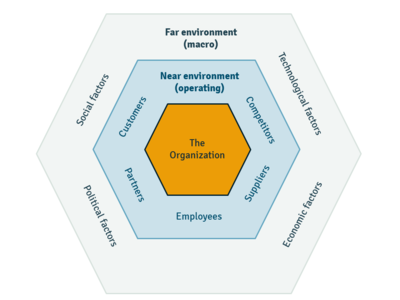Macro environment analysis
Macro environment analysis involves identification of external environment or far environment tha includes a combination of all factors coming from the outside of the organization that affect its performance[1].
Macro environment factors are usually split into four categories:
- political – related to the role of the government
- economical – including exchange rates, business cycles and economic growth
- social – considering demographics, ethics and cultures
- technological – containing the internet access and developed infrastructure.
Additional elements separately mentioned by authors are competitive, environmental and legal factors. Identification of how and which macro environment factors influence company is necessary for efficient strategic management. Maintaining company position and retaining the profits enforce the managers to deal with dynamic changes. The surrounding environment creates opportunities but understanding the factors is essential to avoid potential risks. The success of company is often defined as political stability, low legal barriers and economic development[2].
Key steps in analysis[3]:
- Identify main factors of environment, decide if influence is positive or negative
- Analyze interrelation between factors and trends of change
- Try to identify future influence of factors
- Decide how to plan strategy according to analyzed factors
Typical methods used in macro environment analysis are[4]:
Macro environment changes
The macro environment includes the society norms and political economy what means that any changes in this area have important influence on companies and in the same time all activities performed by entrepreneurs are the response to introduced development. There is well established link between macro factors, political economy, group behavior and way of thinking. This is kind of cycle where the changes in policies lead to fluctuation in macro environment which has direct and indirect effectiveness on people behavior. In literature there is distinguished three different stages which has affected on economy and companies development: colonialism and neo-colonialism where the production dominated the whole market, direct planning and production and the era of the business. Each of them has significantly variant effects on the structure of economy and group behavior as a result[5].
There are a few general sub-indexes which were created to have better possibility for analyzing current macro situation in a country[6]:
- Government budget balance (ME1) – calculated as a percentage of GDP
- Gross National savings (ME2) – calculated as a percentage of GDP
- Inflation (ME3) – annual average percentage fluctuation in customer price index
- General Government debt (ME4) – calculated as a percentage of GDP
- Country credit rating (ME5) – the probability of solvency debt default calculated by the experts
Dealing with the changes in the macro environment enforces the top management of the organization to apply one of response strategies[7]:
- strategic alliances – pooling of resources trough the cooperation of companies
- restructuring – changing the levels and numbers of management
- cost leadership – improving process efficiency and cost reduction
- leadership and culture – motivating and rewarding employees
- pricing – setting profitable prices
- investment – expanding into new markets and innovating
- outsourcing – using external services
References
- Ghasemi R., Mehregan M. J., (2014),Relationship between Macroeconomic Environment and Financial Market Development, European Journal of Economics Finance and Administrative Sciences - Issue, 65, 67.
- Frances S., (2000), Dynamic Interactions between the Macro-Environment, Development Thinking and Group Behaviour, Centro Studi Luca D’Agliano, 143, 1-3.
- Kozlinskis, V., & Guseva, K. (2006). Evaluation of some business macro environment forecasting methods. Journal of Business Economics and Management, 7(3), 111-117.
- Pallapothu M. K., Krause J., (2013),Strategic Macro-Environmental Factor Analysis for Entry into the Fish Vaccines Market in India, School of Business, University of Prince Edward Island, 3, 28.
Footnotes
Author: Justyna Kurnik
